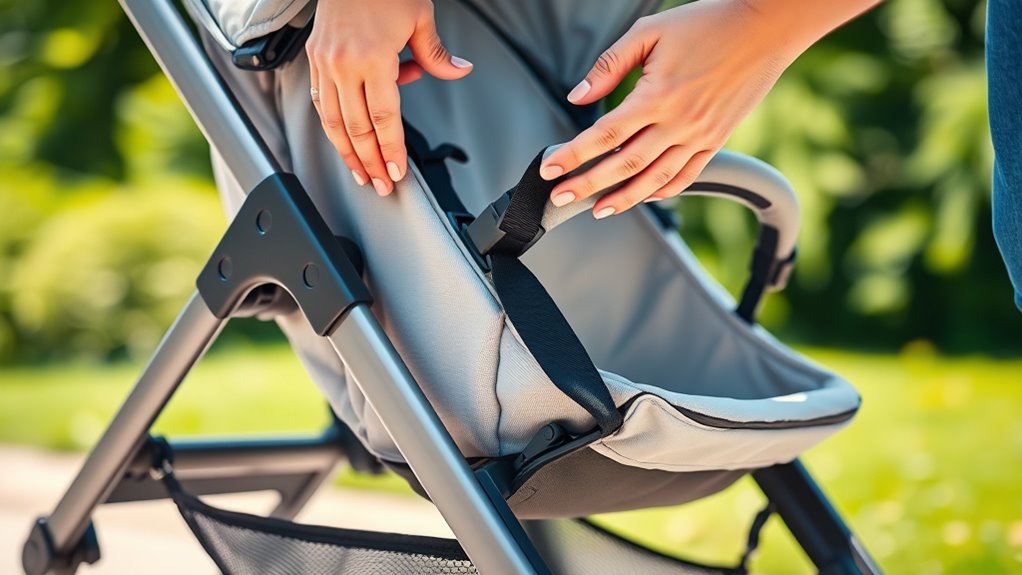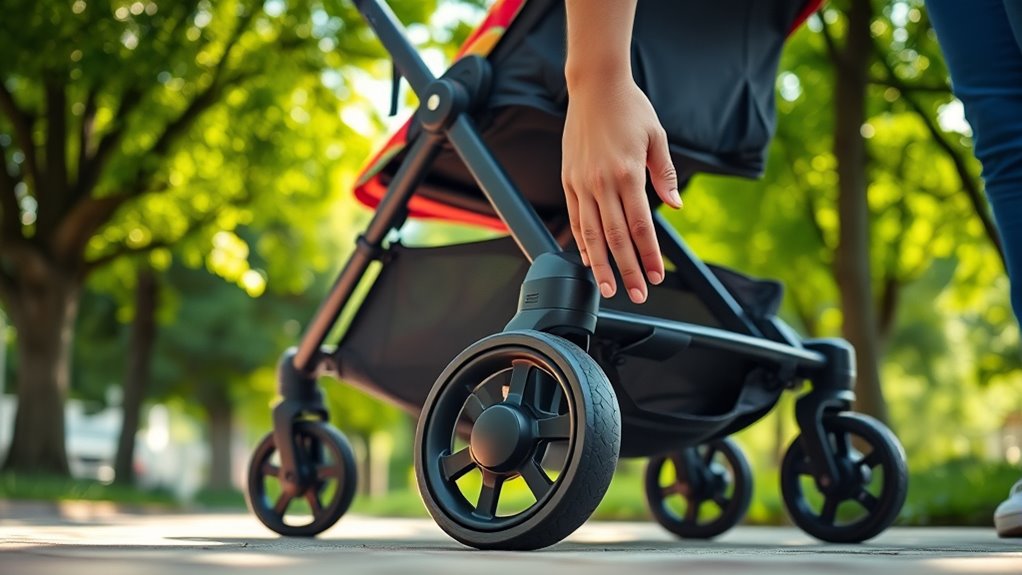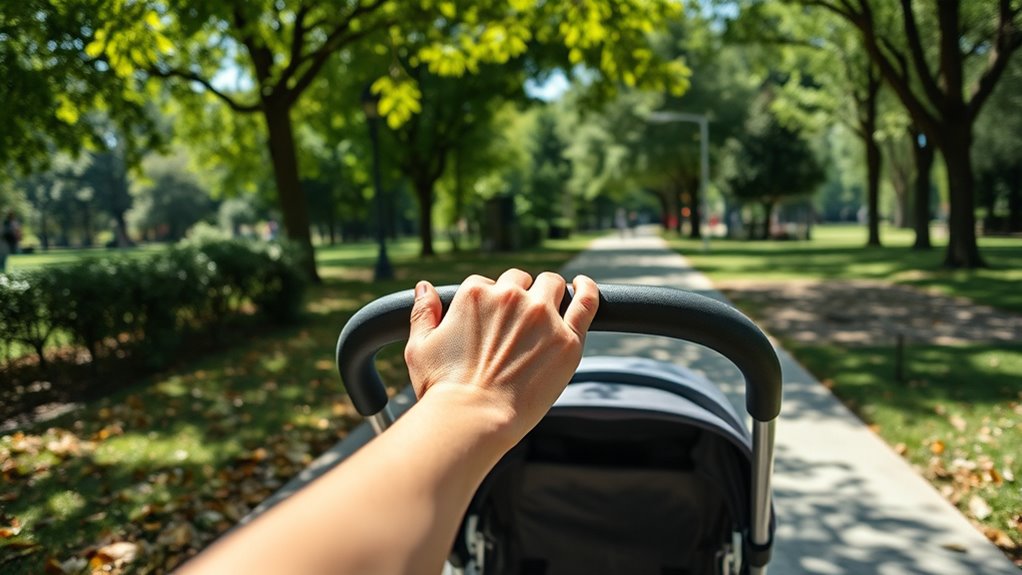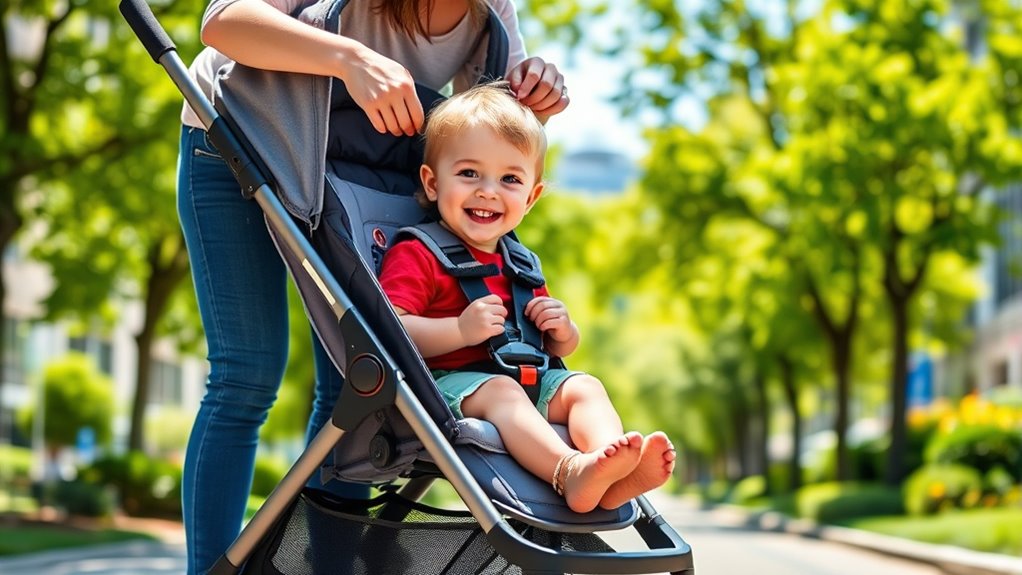To keep your child safe every day, always secure them with a snug harness, making sure all buckles are fastened properly. Regularly inspect your stroller for wear and tear, ensuring wheels, brakes, and frame are in good shape. When stationary, engage the brakes fully and park on level ground. Stay alert to surroundings and obstacles, and when not using the stroller, fold it correctly and store it safely. Keep these safety tips in mind to protect your little one; more expert advice awaits.
Key Takeaways
- Always secure your child with a properly adjusted harness at shoulder and waist level.
- Regularly inspect and maintain the stroller’s wheels, frame, and brakes for optimal safety.
- Use the brakes correctly and ensure they are fully engaged before leaving the stroller unattended.
- Be vigilant of surroundings, avoiding obstacles, busy streets, and poor visibility areas.
- Properly fold and store the stroller when not in use to prevent damage and accidental unfolding.
Always Secure Your Child With Proper Harnessing

To keep your child safe while in a stroller, always guarantee they are properly harnessed. Using correct harnessing techniques ensures your child stays secure during walks. Start by adjusting the safety straps so they fit snugly without causing discomfort. The straps should lie flat against your child’s body and be tight enough to prevent slipping out but loose enough to allow movement. Always double-check that all buckles are securely fastened and that the harness is properly positioned at shoulder and waist level. Avoid loose straps or dangling buckles that can cause injury or become a choking hazard. Proper harnessing not only keeps your child safe but also provides peace of mind, allowing you to focus on enjoying your walk together. Additionally, understanding the impact of proper harnessing on overall safety can help you make informed decisions when choosing and adjusting your stroller gear.
Regularly Check the Stroller’s Condition and Functionality

Regularly inspecting your stroller’s condition and functionality is essential to guarantee your child’s safety during every outing. Consistent stroller maintenance helps identify potential issues early, preventing accidents or breakdowns. During safety inspections, check the wheels for smooth rotation and any signs of wear or damage. Examine the frame for cracks or loose parts, and ensure that all bolts and screws are tight. Test the brakes to confirm they engage properly, and verify that the harness system functions correctly. Don’t forget to inspect the canopy, fabric, and padding for tears or deterioration. Performing these routine checks keeps your stroller in excellent condition, reducing risks and ensuring a safe, comfortable ride for your child. Regular maintenance is your best defense against unexpected safety hazards. Proper stroller maintenance can also extend the lifespan of your stroller, ensuring it remains safe and reliable for years to come.
Use the Brakes Correctly When Stationary

Ever wondered if you’re using the brakes correctly when your stroller is stationary? Proper brake maintenance is essential to guarantee your stroller stays secure. Always check that the brake engages fully and holds the stroller firmly in place before leaving it unattended. Use effective parking techniques, like parking on level ground whenever possible, to reduce strain on the brakes. When parking on an incline, engage the brake tightly and consider placing a wheel chock or wedge for added security. Regularly inspect the brake system for wear or damage, and replace parts as needed. Proper brake use and maintenance prevent unexpected rolling and keep your child safe. Additionally, understanding stroller safety features can help you ensure your stroller’s brakes are functioning properly. Remember, a well-maintained brake system is key to safe, everyday stroller use.
Be Mindful of Your Surroundings and Obstacles

Being aware of your surroundings while pushing your stroller is essential for preventing accidents and ensuring your child’s safety. Urban hazards like busy streets, parked cars, and uneven terrain demand your full attention. Watch for obstacles such as potholes, curbs, and debris that could cause the stroller to tip or jolt unexpectedly. Stay alert when orchestrating crowded sidewalks or crossing intersections, and slow down in areas with poor lighting or limited visibility. Keep a close eye on your path to avoid tripping over obstacles or encountering sudden drops. Being mindful of environmental hazards such as slippery surfaces or loose gravel can further reduce the risk of accidents. By staying mindful of these hazards, you minimize the risk of accidents and keep your little one safe during everyday outings. Your awareness makes all the difference in creating a secure environment.
Properly Fold and Store the Stroller When Not in Use

After steering busy streets and uneven terrain, it’s important to properly fold and store your stroller when you’re finished using it. Establishing good storing routines helps prevent damage and keeps your space organized. Use proper folding techniques to ensure the stroller is compact and stable, reducing the risk of it unfolding unexpectedly or causing accidents. Always follow the manufacturer’s instructions for folding, as each stroller design may require specific steps. When storing, choose a dry, secure location away from sharp objects or heavy items that could crush or damage the stroller. Avoid leaving it in direct sunlight or damp areas, which can weaken materials over time. Incorporating proper storage practices can also contribute to maintaining the stroller’s safety features and overall longevity. Consistently folding and storing your stroller correctly prolongs its lifespan and keeps it ready for safe use whenever you need it.
Keep the Stroller Clear of Small Parts and Sharp Edges

To keep your stroller safe and in good condition, you should regularly check for small parts that could come loose or fall off, especially around hinges, wheels, and storage compartments. Loose small parts can pose choking hazards or cause malfunction. Also, inspect for sharp edges that might cause cuts or scrapes during handling or use. Ensuring all paint sprayer tips are properly fitted and undamaged can prevent paint splatters and maintain a smooth finish.
Frequently Asked Questions
How Do I Choose a Stroller Suitable for My Child’s Age?
You should choose a stroller that is age appropriate for your child’s current size and developmental stage. Consider growth and comfort, ensuring it offers proper support and safety features. For infants, look for seats that recline fully and have secure harnesses. As your child grows, select strollers with adjustable features to accommodate their growth considerations. This way, you keep your little one safe, comfortable, and secure during every outing.
Are There Specific Safety Standards to Look for in a Stroller?
You should look for stroller safety certifications and confirm it meets safety standard compliance. Check for labels from recognized organizations like ASTM, JPMA, or CPSC, which indicate the stroller has passed rigorous safety tests. These certifications help guarantee the stroller’s stability, brake performance, and overall safety. Always verify that the stroller adheres to current safety standards to protect your child during everyday outings.
Can a Stroller Be Used on Uneven or Rough Terrain Safely?
Like a skilled mountaineer steering rugged trails, you can use a stroller safely on uneven terrain if it offers good maneuverability and terrain adaptability. Look for features like large, air-filled tires, a sturdy suspension system, and a lockable front wheel. These elements help you maintain control and stability. Always go slow, stay alert, and adjust your pace to the terrain, ensuring a safe and smooth ride for your little one.
What Accessories Can Enhance Stroller Safety During Outings?
You can enhance stroller safety during outings by adding car seat adapters, ensuring your child’s seat is securely attached. Reflective strips are also essential; they increase visibility in low-light conditions, keeping you and your little one safer. Make sure to regularly check these accessories for proper fit and wear. Combining these safety features helps you enjoy outings with peace of mind, knowing you’ve taken extra steps to protect your child.
How Often Should I Replace My Stroller to Ensure Safety?
You should replace your stroller every few years, or sooner if you notice wear and tear that screams, “I’m unsafe!” Regular stroller maintenance and safety recall checks are your best friends here. Keep an eye out for cracks, loose wheels, or faulty brakes. If your stroller’s looking more Frankenstein than functional, it’s time for a new one. Remember, a safe stroller makes for a happy, stress-free outing!
Conclusion
By securing your child, checking your stroller, engaging the brakes, staying aware of your surroundings, storing it properly, and avoiding hazards, you guarantee safety every day. Prioritize safety with consistent vigilance, constant maintenance, and mindful actions. Protect your little one, prevent accidents, and enjoy peace of mind. Remember, safety is a habit, a responsibility, and a priority—so stay alert, stay prepared, and keep your child safe with these simple, effective tips.









